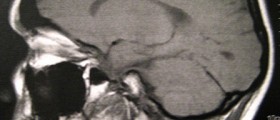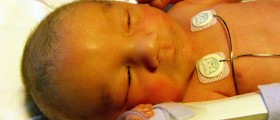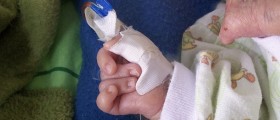Fragile X syndrome, also known as Martin-Bell syndrome, is a genetic syndrome and the most common form of inherited mental retardation, especially in males. Impairments caused by fragile X syndrome are ranging from learning disabilities to more serious cognitive and intellectual disabilities.
Fragile X syndrome most commonly manifests as autism or “autistic-like” behaviors, accompanied by different physical and behavioral symptoms and delay in speech and language development.
- Females with FXS show a similar spectrum of behavioral difficulties compared to males with FXS, but with milder symptoms. Notably, there is a strong association between FXS and autism spectrum disorder (ASD), as ~50% of FXS male and 20% of female patients meet DSM-5 criteria for this disorder, and FXS is the leading monogenic cause of ASD.
- A higher prevalence of seizures, sleep problems, and co-occurring problematic behaviors, especially aggressive/disruptive behavior, is found in the pediatric population with FXS and a diagnosis of ASD than in the FXS population without ASD. Individuals with FXS also widely differ in level of cognitive impairment, while some males with FXS function nearly normally, and others are profoundly disabled. Several studies have reported “high-functioning” males with intellectual ability in the normal to borderline range.
- Numerous additional associated conditions and symptoms of variable severity can occur such as sleep disturbance, seizures, frequent otitis media, strabismus, and joint hyperlaxity. Interestingly, a FXS subgroup has been reported, characterized by hyperphagia, lack of satiation after meals and extreme obesity with a full, round face, small, broad hands/feet, and regional skin hyperpigmentation, referenced in literature as “Prader-Willi-like”.
- This important degree of phenotypic heterogeneity in FXS probably mirrors a heterogeneous genetic background and the cellular-level involvement of various signaling pathways co-regulated by FMRP, such as PI3K and mTOR pathways. Moreover, genetic background plays an important role as shown in animal models (which would result in different patterns of expression of other proteins, including FMRP-interacting proteins).
- In a very recent study, which assessed quantification of methylation, DNA, RNA, and FMRP protein levels in buccal and blood samples, methylation mosaicism was estimated to be slightly over 50%. Molecular-neurobehavioral correlations confirmed the inverse relationship between overall severity of the FXS phenotype and decrease in FMRP levels. Co-occurrence of FXS with an autism diagnosis correlated significantly with 2-fold lower levels of FMRP specially in younger age- and IQ-adjusted males, compared to FXS without ASD, and patients with severe Intellectual Disability had even lower FMRP levels.
- Despite two decades of preclinical work and several clinical trials targeting at least 10 different mechanisms associated with FXS pathogenesis, candidate drugs have been unsuccessful in reaching primary endpoints, and there are still no approved treatments to address the core symptoms of FXS. Well-studied pathophysiological mechanisms of FXS include excessive glutamatergic signaling, endocannabinoid system impaired signaling, voltage-gated ion channel dysfunction, GABAergic system inhibition, or excess of protein translation activity.
Causes
Fragile X syndrome results from damage to the FMR1 gene. This gene is required for synthesizing a protein essential for the proper functioning of the brain. The gene is needed for learning and memory, and also seems to be involved in the development of axons, the formation of synapses, and the wiring and development of neural circuits.
If there is a mutation in the FMR1 gene, the body produces too little of the protein or none at all. Normally, the FMR1 gene contains between 6-55 repeats of the CGG code. In people with fragile X syndrome, the FMR1 allele has over 230-4000 repeats of this code. The more the gene’s code repeats, the more likely there is to be a problem.
The FMR1 gene is located on the X chromosome and this is why the disease is more common in males. Mutation at the FMR1 gene occurs in 1 out of about every 2000 males and 1 out of about every 259 females.
Symptoms
Individuals with fragile X syndrome have varying degrees of mental retardation or learning disabilities and behavioral and emotional problems. Males tend to be more severely affected than females. Along with the intellectual disability, major symptoms of the syndrome include an elongated face, large or protruding ears, flat feet, larger testes (macroorchidism), and low muscle tone.
Speech problems may manifest as cluttered speech or nervous speech. Behavioral characteristics usually involve stereotypic movements, atypical social development, shyness, limited eye contact, memory problems, etc.
Inheritance Patterns
Fragile X syndrome is an X-linked dominant condition. This means that fragile X syndrome can be passed from a carrier mother to her children. Fathers with the fragile X syndrome cannot transmit it to any of their sons, as fathers pass only the Y chromosome to their sons. However, fathers will transmit the pre-mutation to all of their daughters, as males pass their X chromosome to all of their daughters.
Females that have one copy of the fragile X can transmit it to their sons or daughters. Each child will have a 50% of chance inheriting the fragile X. Sons who receive the fragile X will be more prone to developing intellectual disability. Daughters who receive the fragile X may even appear normal or be moderately intellectually disabled, usually to a lesser degree than male offspring.
Inheritance patterns of fragile X syndrome are very complicated and each person with a history of fragile X syndrome should consult a medical geneticist or a genetic counselor to learn more about the risks.


















Your thoughts on this
Loading...